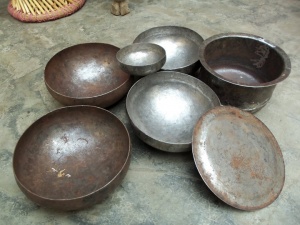Sarbloh: Difference between revisions
From SikhiWiki
Jump to navigationJump to search
Hari singh (talk | contribs) No edit summary |
Allenwalla (talk | contribs) m (removed inappropriate video using aluminum to create cast iron) |
||
| Line 1: | Line 1: | ||
[[Image:SarablohBate.jpg||thumb|300px|right|Some Sarabloh Utensils]] | [[Image:SarablohBate.jpg||thumb|300px|right|Some Sarabloh Utensils]] | ||
'''Sarbloh''' is the metal | '''Sarbloh''' (wrought iron) is the metal used in the [[Bata]] (a bowl or cauldron) used by Guru Gobind Singh Ji to prepare the [[Amrit]] during the Khalsa initiation ceremony in [[1699]]. The [[Khanda]] (a double edged knife or sword) was also made of Sarbloh. To this day all [[Amrit Sanchaar]]s are conducted using a bata and khanda made of sarbloh. | ||
[[Kara]] and [[Kirpan]] (2 of the [[Five Ks]] that a Sikh keeps on his or her person at all times) must be made of Sarbloh. | [[Kara]] and [[Kirpan]] (2 of the [[Five Ks]] that a Sikh keeps on his or her person at all times) must also be made of Sarbloh. | ||
Sarbloh should not be confused with either cast iron or steel as these metals only came into common use during the industrial revolution of the 19th century. | |||
A video on how Sarbloh is made: | |||
==see also== | ==see also== | ||
Revision as of 00:01, 2 January 2011
Sarbloh (wrought iron) is the metal used in the Bata (a bowl or cauldron) used by Guru Gobind Singh Ji to prepare the Amrit during the Khalsa initiation ceremony in 1699. The Khanda (a double edged knife or sword) was also made of Sarbloh. To this day all Amrit Sanchaars are conducted using a bata and khanda made of sarbloh.
Kara and Kirpan (2 of the Five Ks that a Sikh keeps on his or her person at all times) must also be made of Sarbloh.
Sarbloh should not be confused with either cast iron or steel as these metals only came into common use during the industrial revolution of the 19th century.
A video on how Sarbloh is made:
see also
References
<References>

